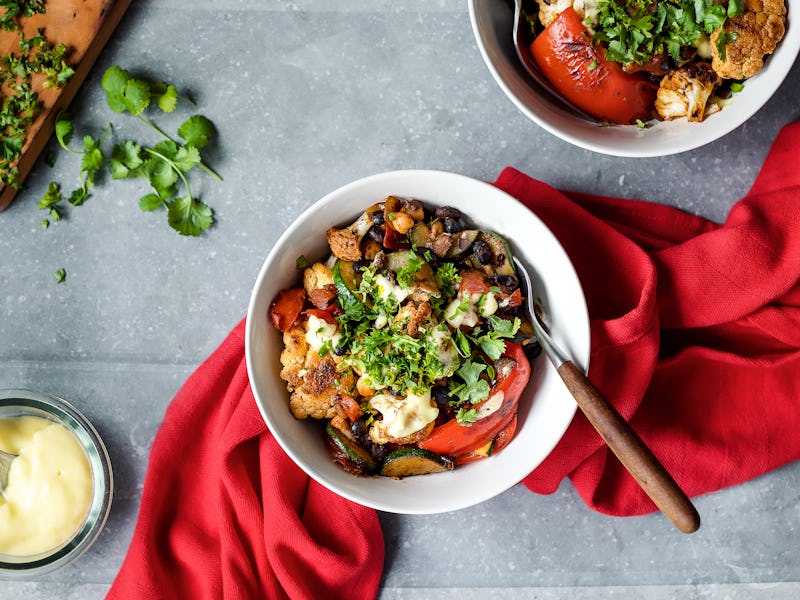A Budget-Friendly Guide to Healthy Eating for Less
You don't need "superfoods" to eat well.

The idea that healthy food costs more than junk food is something I hear a lot. Students tell me they’d like to eat better but can’t afford to. There is a strong belief that cooking from scratch costs a fortune, and with takeaway meals priced as low as £1 ($1.27), they have little incentive to change their behavior.
The past decade has seen increased media attention on healthy diets, and stories about the cost of healthy eating are also on the rise, all of which influence public perception. Some studies comparing the price per calorie of foods suggest less healthy foods are often cheaper, but they don’t tell the whole story. The metrics used to measure cost are important.
Consider the example of two pots of chocolate dessert, one regular and one with less fat. Using the price-per-calorie measure, the lower-fat dessert appears more expensive than the regular pot because it contains fewer calories. But studies comparing the price per unit weight of food from the same food group suggest healthy options are often cheaper — for example, 200g of chickpeas versus 200g of bacon. The latter is a more meaningful measure because most people buying food think about the quantity they are buying rather than how many calories they are getting for their money.
Changing Habits Early
The global obesity rate has tripled since 1975.
Expanding waistlines is a growing public health concern. Globally, the rate of obesity has tripled since 1975. According to the World Health Organization, more than 1.9 billion adults are overweight, of which 650 million are obese.
The younger generation is especially affected by high-calorie, low-nutrition foods. High levels of sugar, fat, and salt put children at increased risk of type 2 diabetes and heart disease, not to mention tooth extraction. Perhaps more worryingly, habits formed in childhood seem to stick for life. This is a tragedy because these problems are avoidable. It is possible to eat healthily for less — much less — than the price of a cheeseburger. The crux of the issue is not cost, but knowledge, skills, and time.
We are increasingly conditioned to think of healthy food as expensive, because of the price of meat, fish, and dairy, the rise of “superfoods,” and the higher cost of organic produce. Yet nutritious food needn’t cost the Earth. Chia-seed smoothies are an expensive luxury; basic nourishment —carrots, lentils, potatoes – is cheap as chips.
Time Poor
Poverty is exhausting and this in part drives food choices. Often the last thing people want to do at the end of a long day is cook, so cheap takeaway meals are appealing.
People on low incomes are more likely to buy calorie-dense foods instead of fruit or vegetables because they are more filling. But while a cheeseburger might fill you up for longer than an apple, junk food is bad for our health.
It is possible to cook a filling, healthy meal in very little time, as the British food writer, Jack Monroe, has shown repeatedly. For example, her recipe for a zucchini, tomato, and cheese gratin costs 33p and takes eight minutes to cook. It’s healthier and cheaper than takeout.
But promoting healthy eating in a cash and time-poor society is difficult, and teaching cooking skills alone won’t do it. Jamie Oliver’s campaign to teach cooking skills to people on low incomes, while well-intentioned, alienated much of his intended audience by demonizing the turkey twizzler and further stigmatizing families living at the sharp end of austerity in Britain. What we eat is central to our identities, and strategies to address diet need to recognize this if they are to work.
Top Tips
Beans are cheap and nutritious.
So how can you eat better on a budget? Meat and fish are among the most expensive items on a shopping list, while plant protein often costs less. Pulses (beans, peas, and lentils) are nutritious, very cheap, and work well in place of meat.
Don’t be fooled by expensive “superfoods”; there is no agreed definition for this term, and many so-called superfood health claims remain unproven. Simply increasing the volume and variety of fruit and vegetables in your diet is shown to reduce the risk of ill health and needn’t be costly.
Frozen, canned, and dried fruits and vegetables are often cheaper than fresh but keep their nutrients. They also keep for longer, meaning less food waste.
Avoid buying processed foods; often you can make similar dishes quickly and easily for much less. This recipe for pasta sauce costs 50p for four portions, while a jar of pasta sauce costs over four times this price, and, as a bonus, you’ll know exactly what’s in it.
Diet is fundamental for health and well-being, and the cost of food alone should not stop people from eating well. Junk food may be cheap and tasty, but the idea that healthy food is expensive is just fiction.
This article was originally published on The Conversation by Charlie Middleton. Read the original article here.